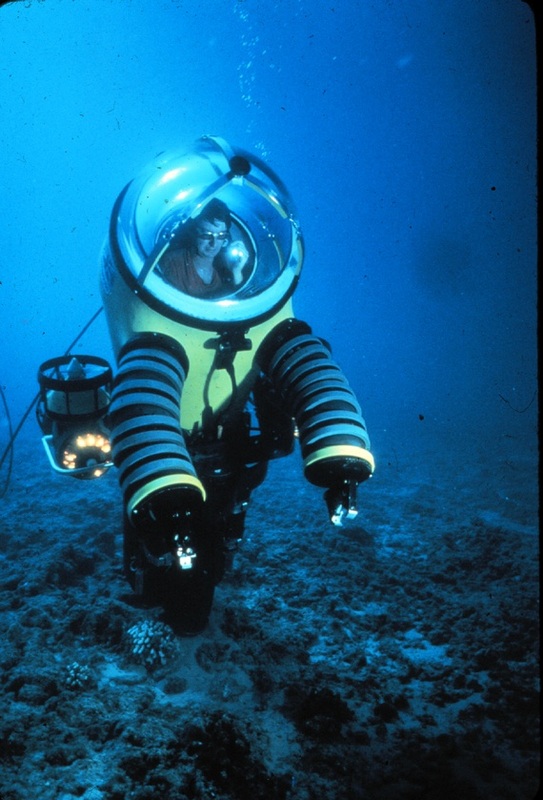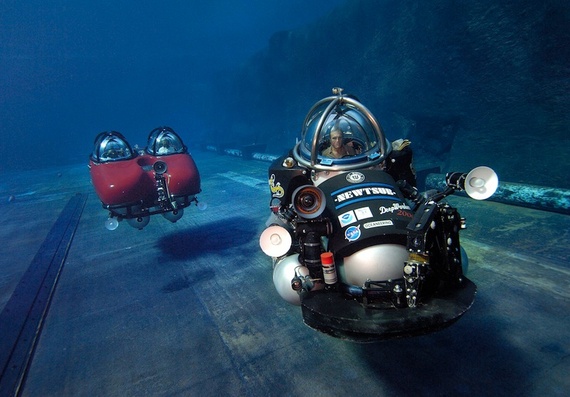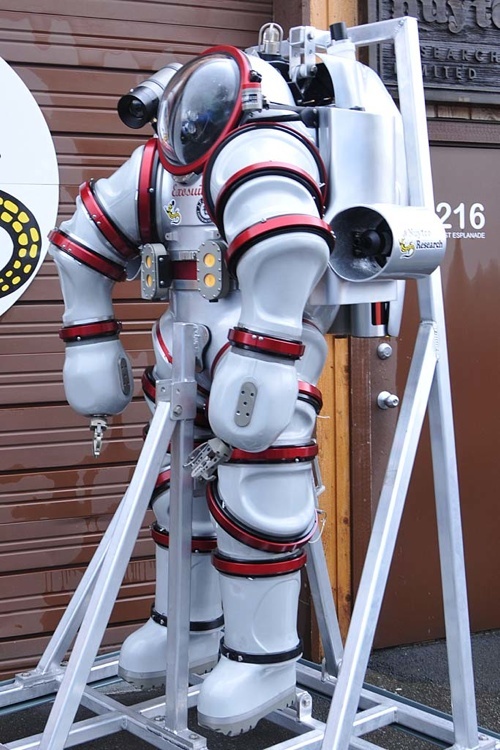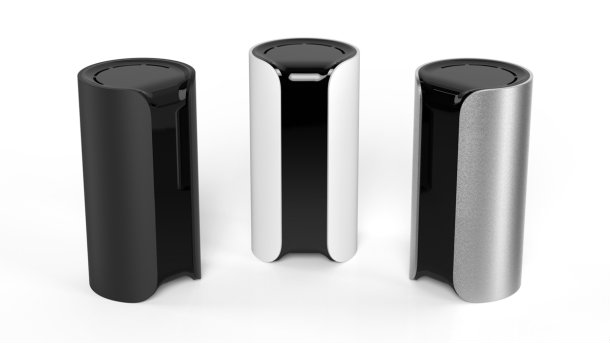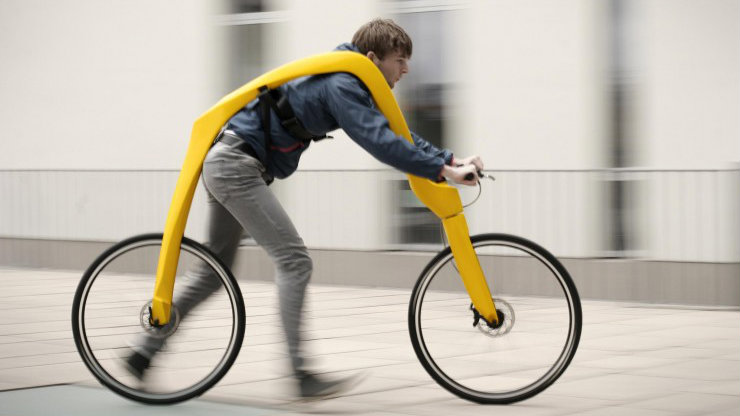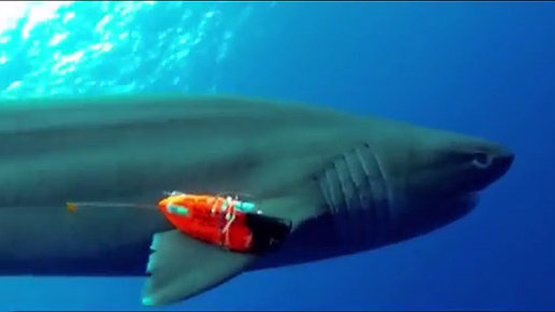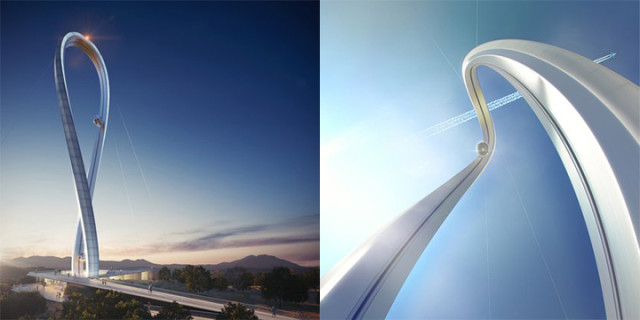|
The Diving Bell and the Exoskeleton: An Excursion into the Depths
If you want to dive deep, there are only two ways: transform your body or wear armor.
A search for a photo of a miniature submarine took me to a government website, and as I browsed the tiny thumbnails, I saw something better than a tiny sub in the water. I found a picture of a man standing on the bottom of the ocean. And I've been staring at it for a week. In the image, we see a yellow exoskeleton with two grey tubey arms ending in pincers. A clear cupola forms the top. What appears to be a thruster attaches to one side, and perhaps the other. Inside, a man in a t-shirt looks out into the water with a flashlight.
The imagination spins wildly through science fiction scenarios--Forbidden Planet! Bioshock!— landing on this one: a colony of undersea humans repurpose dopey robots from the pre-electronics age into mech suits for the ocean floor. As it turns out, this is not so far from the truth. The people who made them are underwater inventors who tested their contraptions with their own bodies, and their stories are crazy. And I'll tell you this much about who uses them: Navy submarine rescue squads, oil companies, and a new scientific expedition to study bioluminescent life. But before we get there, we're going to have to learn a little bit about the realities of the subsea. Deep diving is one of the most preposterous activities in which humans engage. Put it this way: diving below a few hundred feet into the ocean pushes the human body farther outside its natural limits and tolerances than walking in space. But unlike space, the oceans contain resources that firms can profitably extract. In the 1960s, oil companies began drilling offshore in the North Sea, Gulf Coast, and in the water near California. Building drilling rigs requires divers. So, a lot more people have ventured below than have gone on orbit. The divers do the dirty work: welding, laying foundations, inspecting pipes. These aren't just guys in scuba gear. Recreational scuba divers stop at 100 or 150 feet of depth. Beyond that range, the human body can't function normally. First, there is the bends. As people descend in the water, gases (mostly nitrogen) diffuse into their tissues. That's fine, but as they ascend, and the gas comes back out of their blood and ligaments and liver and muscles, it can form bubbles if the divers come up too quickly. Those bubbles can cause pain and serious injury if they end up in the wrong place. People learned that they have to ascend slowly, stopping for long periods of time at set depths. Decompressing slowly is best, and the longer and deeper the dive, the longer it takes. We're talking a day, a week, or more in some cases to fully decompress. Two other physiological problems emerge as the divers sink into the darkness. First, the nitrogen makes them feel high. "You end up feeling basically drunk," one diver told me. "In warm clear water, it can be euphoric. In dark cold water, it can be frightening, very frightening." Simply put: If one is breathing air, the brain begins to stop working below 130 feet. Second, oxygen becomes toxic at lower depths, too. It can cause symptoms from twitchiness to full-blown seizures. Both these problems can be mitigated by the use of more exotic gas mixes than air. Divers substitute helium for nitrogen and most of the oxygen. Generally speaking, they end up breathing a variant of heliox that's 90 percent helium and 10 percent oxygen. The pitch of the divers' voices bends upward, like teenagers inhaling the gas in a balloon. For serious commercial work, though, even these little human body hacks don't cut it. Those divers need to be able to work for hours and not spend days decompressing afterwards. So, a labor model called "saturation diving" became popular with the oil companies. For weeks, divers live and work at high pressure, keeping the gases in their tissues. They move from pressurized living quarters to a diving bell to the sea floor and back, where they're tended to by a support team that sends food and supplies in through pressure locks. A diving bell used to carry divers to the wreckage of the USS Monitor (National Archives).The oil companies contract with companies like CalDive, Helix Energy Solutions, and Oceaneering (remember that name). They train the divers, man the facilities, and acquire the jobs.
The work is physically demanding, and the living conditions are cramped and weird. Nathaniel Rich described them in an essay last year in the New York Review of Books: A saturation diving complex looks like a small space station. It comes in different sizes, accommodating six to twenty-four divers. A typical complex, which sits on the deck of a ship or an oil rig, has four main components. The first is the living chamber, which resembles a train’s sleeper car, or the berth of a submarine, and has double-decker cots with fire-retardant mattresses and a sitting area with a television screen. (Larger systems have two or even four separate living pods.) A camera—often referred to as “big brother”—peers through a porthole, observing the divers. Other portholes, covered with plexiglass, allow the marooned divers to glimpse the outside world. Why would anyone work under these conditions? There's the challenge of it. The James Bond of it. The wildness of it. But really, the appeal is simple: "The deeper you dive, the more you get paid,"Rich wrote. And the only way to go deep is to go saturated. It's been this way since the 1960s. Saturation diving is, on the face of it, totally nuts. Some divers die: three in the North Sea in 1971 alone. Why were we sending these young men out there like this? There has to be some other way, right? Perhaps. The Tritonia suit, left, the precursor to modern atmospheric diving suits.The year was 1935 and a boat sat bobbing in the sea south of Ireland at precisely 51° 25′ 0″ N, 8° 33′ 0″ W. Three hundred feet below lay the RMS Lusitania, a massive passenger ship sunk by a German U-boat in 1915. Sailors were gathered around two divers who were going to plunge into the ocean.
The man on the right wears standard diving dress for the time. You'd probably recognize it, distilled in your mind from the undersea exploration montage sequences. It's a big, heavy suit with thick insulation. The helmet looks like a cannonball with a window cut out. The boots are cinched tightly. To the left of this diver stands an even more amazing artifact of the times, a hulking suit of cast magnesium. Armor for the sea! This is the Tritonia atmospheric diving suit (ADS). It is robotomorphic: in essence, a metal cylinder with jointed legs and arms. The arms end in pinchers, the legs in shoe-like platforms. The headpiece looks like a stolen submarine hatch. The suit is larger than any man. The Tritonia is properly thought of as a human-shaped submarine. With a diver named Jim Jarrett inside, the suit was winched up and overboard. What the Tritonia gave up in mobility, it made up for in relative comfort. Jarrett fell through the water column dry and breathing a mix of gases that we'd just call air. He didn't need heliox or to deal with the effects of the pressure. The exploration was a success. He explored the sunken ship and lived to tell the story. Despite the success of the Lusitania dive, the British Navy never got interested in the Tritonia, and its inventor, Joseph "Pop" Peress, went on to other things. The suit itself, somehow or another, ended up in "an old junk shop in Glasgow, Scotland," according to the Naval Undersea Museum, where it sat awaiting a new imagination. In the late 1960s—with North Sea diving booming—two Britons, Mike Humphrey and Mike Borrow, formed Underwater Marine Equipment. They'd decided to build their own atmospheric diving suit. Through their research, they found their way right back to Joseph Peress and the Tritonia suit, tracking it down in Glasgow and refurbishing it. Legend has it that the Peress himself, who was born in the 19th century, tested the restored suit. In 1971, the inventors finished their own version, the JIM suit, named after Jim Jarrett. They formed a company called DHB Construction to commercialize their invention. And they hired a very young engineer named Graham Hawkes. He's the man in the photograph, the one with the flashlight. "One of the things that's very different from scuba is that you're breathing normally and there are no bubbles. You are very aware of your breath. This is gonna sound a little strange, but: You can't see water. There is no splashing. There's no nothing. It just felt like I was standing on an alien planet. I felt like I was on the surface of the moon. The water was so clear, it looked like a hazy atmosphere," Hawkes told me about standing on the bottom of the Atlantic Ocean in a JIM suit. "There were small creatures burrowing. What we know as sediment was drifting away—it looked exactly like smoke. I was just wrestling with all of these images which nothing can prepare you for," he said. "I was an adult at that point but there is no precedent for it. Everything looks alien and all you want to do is let your jaw hang slack and just stare and try to absorb stuff." "It was the first time I'd ever dived in the ocean. I'd never scuba dived. I'd never even really snorkeled. I'd been in all kinds of Navy tanks testing these things, but never in the ocean," Hawkes said. "It was a commercial operation with a JIM to try and salvage some things, which were in the Atlantic. And I ended up jumping in the JIM suit and standing on the seafloor at 300 feet. I was supposed to be walking around looking for supertanker anchors, big massive chains. There was supposed to be one near me."
"But what happened was, I was stunned by the sea life. I must have been this great big alien that just landed there, but nobody cared. If you go into a forest, all the animals kind of flee. Here they were all just carrying on, and there are things crawling around on the sea bed and fish and things flapping past me. And they were not fleeing. I ended up turning around and around and around just staring at the sea life. I was just in awe. In turning round and round, I ended up digging a hole. I dug such a hole that by the time I came out of my reverie, I asked the top side to lift me up and they just dragged me all the way out of there," Hawkes concluded. Hawkes is not describing the moment in the photograph that inspired this story. He is, instead, talking about his first experience with a JIM suit in the ocean. He spent a lot of time in these suits in those early years. While the JIM suit had its advantages over saturation diving, the user experience was not pleasant. The JIM suit's leg mobility max, from a US Navy report.As one descended, the viewports were designed to slide in a bit, but they didn't slide in smoothly. They'd pop into place and Hawkes says it was like having a rifle go off in your face ... as you're descending hundreds of feet into the abyss. Saltwater and oil from the joints would pool around one's feet. And as he moved the limbs of the suit, they tended to "grab a piece of flesh and bite you," Hawkes put it.
The mobility of the suits was limited and required a lot of strength. The legs, such as they were, could not bend at the knee, so the people testing them had to swing their legs out to do any kind of locomotion. Imagine walking on stilts. It took the some getting used to. Lieutenant Robert C. Carter of the US Navy evaluated the JIM suits in 1976. Their maximum walking speed was about 50 feet per minute, a small fraction of a regular person on land. Among the tasks JIM suit divers tried, they found "the type of short, gross movement exemplified by sawing" to be the suit's forte. One of them shows up in the 1981 James Bond movie, For Your Eyes Only, worn by a bad guy who attacked Bond. This is the JIM suit guy delivering a slow-motion underwater blow to 007's face. I imagine that this is about as realistic as a Michael Bay sequence in Transformers. A JIM suit in For Your Eyes OnlyBecause of these limitations, Hawkes and his colleagues were eager to improve on the suit. But by that time, a company providing subsea services (mostly saturation diving) to the oil industry had purchased DHB and all the rights to its technology.
For a few years, the history gets tumultuous and legally colorful. Hawkes says Oceaneering basically wanted the ADS to die because it threatened their core business of saturation diving services. He left the company to develop the WASP, which is the suit he's wearing in the original photo. Locomotion was achieved with the thrusters on the sides of the suit, which were controlled by foot pedals. Oceaneering sued him, claiming that he'd taken the work he'd done while employed there and run off to start his own company. Eventually, they settled, and Hawkes' company ended up building WASPs for Oceaneering. Meanwhile, Hawkes met the famed ocean explorer Sylvia Earle. They married (they're now long divorced) but Hawkes stopped working on atmospheric diving suits. Now, he makes special submarines that look like planes that fly underwater. One of his clients is the famed (and recently infamous) venture capitalist Tom Perkins.The subs look like this: But the ADS story doesn't end with the JIM and WASP. After Hawkes exited the field, Phil Nuytten, who had been one of the founding partners of Oceaneering, kept up the development of the ADS.
Nuytten, like the original partners of Underwater Marine Equipment, was someone who'd seen the potential of a suit like this. He'd been a champion spearfisher and octopus wrestler(!) as a teenager. That's also when he started the first dive shop in Vancouver, British Columbia, where he made custom wetsuits, too. Beginning in the 60s, he wanted to make an ADS. But his partners were more interested in protecting their saturation diving profits. "Why the hell would we want to develop a diving suit that is in direct conflict with our core business?" Still, Nuytten pressed on. In the early 1980s, he developed a new technology called the Newtsuit. He sold out of Oceaneering, formed a new company called Hardsuits, Inc, and got a huge order from the US Navy, but his design and technology were bought out from under him in a hostile takeover bid (oh, the 80s!). Something like a hundred Newtsuits were manufactured. Mostly they were sold to navies, but also to the oil field contractors. So Nuytten went on to other things. Other things like developing miniature submarines called DeepWorkers for doing subsea inspections. Eventually, though, he worked his way back to his original idea, 40-some years after the JIM. Beginning in the early 2000s, he and his team began to sketch out a better ADS. They finished the first prototypes around 2009 and delivered their first Exosuit in early 2013 to the company J.F. White, a major contractor. The Exosuit looks a lot like the previous generations of ADS, but as drawn by a superhero comic book artist channeling Honda's robot aesthetic. Nuytten can tick off all the ways that new Exosuit is superior to the Newtsuits and their later variants. For one, electronics have made so many things easier. And they've improved the safety, too, because the Exosuit can be remotely operated from the surface through its fiber optic link.
"If anything happened to the pilot," he told me, "You can fly them right to the surface. The suit has a camera that mounts on the head piece and you see everything the pilot sees. You can take over control from the surface." But the biggest change is the upgrades Nuytten gave to the joints. That's led to marked improvements in mobility. It required one foot-pound of torque to move the wrist joint of the Exosuit. The old suits would have required "three, four, five times that," Nuytten said. Now, he maintained, the force required to move around is very similar to a space suit. They're also working on manipulators that are less pincer and more human hand. "You'll put your hand into a glove, which is filled with sensors," he said, "and as you move your hand, it will move the outside fingers in real time to match your movements." Slowly, slowly humans are moving towards being able to act like ourselves in the deep water. This summer, the Exosuit will be deployed off the coast of New England to study bioluminescent creatures in their diurnal migration from the depths up to the surface. Diver Michael Lombardi will walk up a short step ladder and shimmy down into the suit, which hinges opens at the waist. He'll cross his arms on his chest, and the top portion will be lowered down. It's a really tight fit. So, sfter the waist is locked together, he'll wiggle his left elbow into one of the arm holes, then use space to free his right arm and stick it into the sleeve. The left follows easily. Then he'll be sent overboard and down 1,000 feet with an ROV companion, where he'll remain suspended over the true deep ocean. He expects to make two to three dives per day, each lasting four to five hours. If he's lucky, and things work as expected, at certain times, he'll be surrounded by fish making their own light as they swim upwards. Sylvia Earle, the explorer and Hawkes' ex-wife, once said this kind of experience was like "falling through the stars." On the other end of the spectrum, the Navy wants to use the Exosuit, and its future technological descendants, in submarine rescue missions. They're currently supporting research into lighter weight materials, improved joints, and better prehensors. They're figuring out ways to protect these frail bodies. "People have the idea that humans are very tough, very resilient, and that is complete baloney. We are not like cockroaches. We are very fragile. We are like a water bag full of chopsticks," Nuytten told me. "We can't go to Mount Everest and we can't go to the bottom of the ocean. But we do go there. We use the armor of technology to go outside our design specifications." So why aren't people like Hawkes scared when they go to the bottom of the sea? "I can't tell you why. The deep ocean is a very nice, quiet, benign place. For some reason, and it's not just me, you feel remarkably at home down there," he said."I've made dives where you spend a few hours. You get used to this tranquil place, no howling winds or blinding sunlight. And to surface and get dragged out, and suddenly there is light and noise. It's very rude. The drama is actually coming back." At the end of our conversation, Hawkes and I returned to the subject of the photograph. He told me there is an optical effect caused by the acrylic material of the dome that miniaturizes him. If you look closely, the same is true of many other subsea photos. Down there, we are tiny. Source: TheAtlantic
Uhm, did you read this article? Share it now - your friends need to know about Exosuits!
|
We Share Stories Like this Every Day
Follow us to get your Daily Tech Recap! Latest Geeky Goodness:
|
| Recaply Copy |
|
